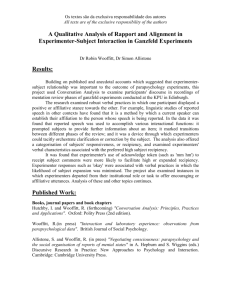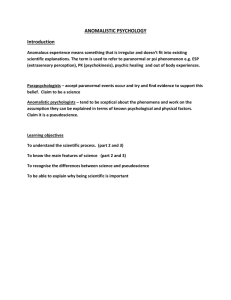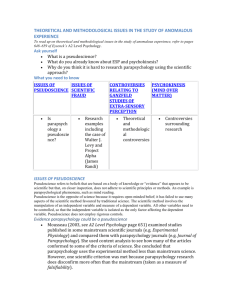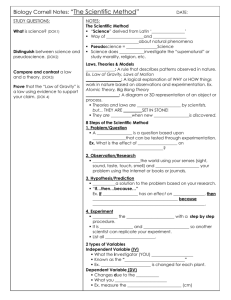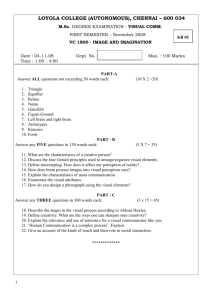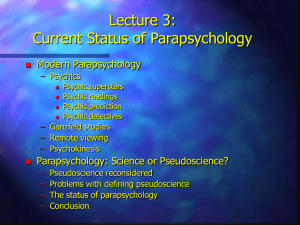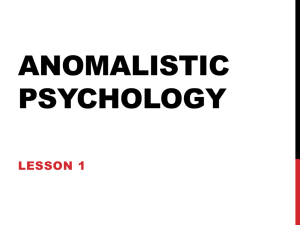File
advertisement
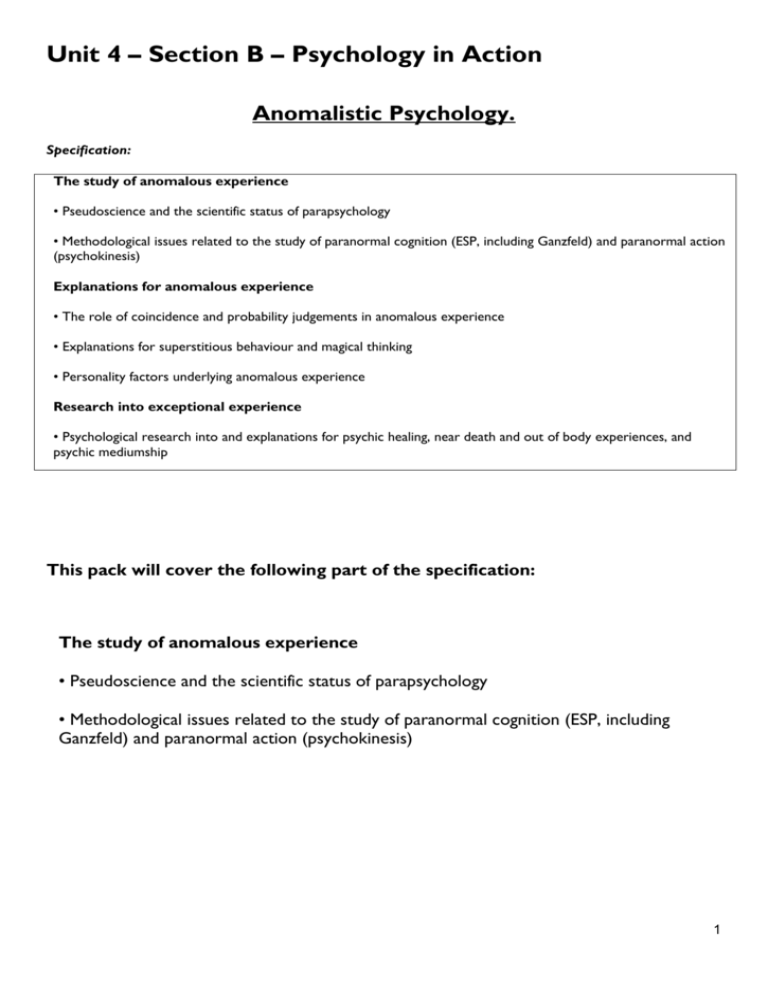
Unit 4 – Section B – Psychology in Action Anomalistic Psychology. Specification: The study of anomalous experience • Pseudoscience and the scientific status of parapsychology • Methodological issues related to the study of paranormal cognition (ESP, including Ganzfeld) and paranormal action (psychokinesis) Explanations for anomalous experience • The role of coincidence and probability judgements in anomalous experience • Explanations for superstitious behaviour and magical thinking • Personality factors underlying anomalous experience Research into exceptional experience • Psychological research into and explanations for psychic healing, near death and out of body experiences, and psychic mediumship This pack will cover the following part of the specification: The study of anomalous experience • Pseudoscience and the scientific status of parapsychology • Methodological issues related to the study of paranormal cognition (ESP, including Ganzfeld) and paranormal action (psychokinesis) 1 Introduction to topic What is Anomalistic Psychology? Anomalistic psychology is the study of extraordinary phenomena including (but not restricted to) those which are often labelled "paranormal". It is directed towards understanding bizarre experiences that many people have without necessarily assuming a priori that there is anything paranormal involved. It entails attempting to explain paranormal and related beliefs and ostensibly paranormal experiences in terms of known psychological and physical factors. What is Parapsychology? Parapsychology is different to anomalistic psychology; it is the “scientific” investigation of the "paranormal" – phenomena that cannot be explained in terms of currently accepted scientific theories. Paranormal activity can be defined as experiences that lie outside the range of normal experience or scientific explanation or that indicates phenomena understood to be outside of science's current ability to explain or measure. Paranormal phenomena is generally agreed to consist of perceived activity and experiences inconsistent with the world as already considered to be understood through empirical observation coupled with scientific methodology. Parapsychologists tend to try to find evidence supporting the paranormal, whereas anomalistic psychologists are more sceptical. This has led some people to consider Parapsychology to be a pseudoscience. Pseudoscience and the scientific status of parapsychology Pseudoscience Pseudoscience actually means ‘false science’ Pseudoscientific explanations can be difficult to identify because they are presented as being scientific even though they do not meet the criteria for true science. Look at these statements below. Decide which should be labelled as characteristics of Science, and which should be labelled as having characteristics of Pseudoscience. Characteristic Aims to test theories in order to refute (falsify) them. Science or Pseudoscience? Aims to confirm rather than refute its own theories, putting the burden of proof on sceptics. Uses flawed methodology and anecdotal evidence to substantiate claims. Relies on objectivity and replication to produce valid evidence. Proposes unfalsifiable hypotheses and fails to correct its self when claimed effects don’t occur in research. E.g. the phenomena disappear when sceptics are present Rejects theories when they don’t fit with sound evidence from research Makes and tests predictions to build up increasingly accurate knowledge about the world. Fails to build on or connect with existing scientific knowledge - so progress is impossible. Uses scientific terminology with precisely defined meanings to ensure clarity. Uses complex scientific jargon with imprecise meanings to give a superficial air of ‘science’ Avoids peer review Research is submitted to expert peers for review before publication 2 Identifying aspects of pseudoscience For each statement identify and explain which aspect of pseudoscience it demonstrates: Some creationists claim that God made the earth with signs of prior aging, such as fossils in rocks, already in place. Western astrology has changed very little over the past 2500 years. Pseudoscientists often publish straight to books, magazines or on the internet. Claims for psychic healing working usually rely on personal testimony of those it has treated. Psychic healing uses imprecise terminology such as vibrations, energy, fields and harmonization. Many UFOologists argue that UFO sceptics cannot provide watertight explanations to refute every single UFO sighting put before them, so the UFOologists argue that the sceptics should admit that UFOs exist. Why may pseudoscientific areas such as psychic healing and psychic medium ship raise ethical issues? 3 The Principle of Occam’s Razor Occam’s razor is the principle of simplicity – if there are two competing explanations then, all other things being equal, the simpler one is to be preferred Many pseudoscience explanations are very complicated, so Occam’s razor would suggest a simpler often nonparanormal explanation is the better one. Others argue that the simplest explanation does not have to be the correct one. Look at the picture on the left. Now give an account of it in terms of: A) A paranormal explanation B) A non-paranormal explanation Which of your explanations is most likely to be accepted under the principle of Occam’s razor? Scientific status of Parapsychology It has been argued that anomalistic psychology uses the scientific method to establish truths about paranormal phenomena, whereas parapsychology uses pseudoscience, or in some cases ‘fraud’ as an explanation for the phenomena. However, there is a debate about to what extent parapsychology is a ‘true’ science or a pseudoscience. 1) There are many practitioners, theories, claims and methods arguably labelled as pseudoscientific in parapsychology, but this is also true in other fields in psychology for example, psychoanalysis. Does this defend parapsychology as a science? Why? 2) In a comparison between the contents of mainstream scientific journals (for example, the British Journal of Psychology, Molecular and Optical Physics) and “fringe” journals (Journal of parapsychology, journal of scientific exploration) researchers have found that: a) Many studies in the fringe journals showed disconfirmation of the established theory, Mousseau (2003) found almost half of her sample of fringe journals showed disconfirmation. None of a similar sample of mainstream scientific journals had studies of disconfirmation. Does this add weight to parapsychology as a science or pseudoscience? (Hint: Think about falsifiability) Why? b) A pseudoscience may use little mathematics or logic, but researchers found a similar level of good statistical practice for both studies reported in the fringe and mainstream scientific journals Does this add weight to parapsychology as a science or pseudoscience? Why? c) It is thought that a lot of parapsychology uses testimonial and anecdotal evidence to support its claims. Mousseau (2003) found that in her sample of fringe journals, there were a lot of testimonial and personal 4 accounts for phenomena such as ‘psychic healing’ and ‘haunting’. Although she states that 47% of studies had an empirical nature, and almost a quarter reported laboratory experiments Does this add weight to parapsychology as a science or pseudoscience? Why? 3) In parapsychology, only certain researchers seem to get positive results, while replications by other researchers do not find similar positive results. Alcock (1981) suggests that this may be caused by experimenter effects or unintentional bias, and this subjectivity undermines the scientific nature of the research. Does this add weight to parapsychology as a science or pseudoscience? Why? Referring to the major features of science, discuss the scientific status of Parapsychology. (6 marks) There is evidence to suggest a scientific element in Parapsychology for example…… However, critics of Parapsychology being scientific would point to the contrary evidence that suggests….. Therefore, Parapsychology could be considered …………..(make a conclusion – science or pseudoscience?) 5 The study of paranormal cognition: Ganzfeld studies of ESP ESP is Extrasensory perception which involves reception of information not gained through the recognized physical senses but sensed with the mind. Telepathy is an example of ESP – conveying messages through the mind. Ganzfeld studies are a way of measuring telepathy. What are Ganzfeld studies? In a typical Ganzfeld experiment, a "receiver" is placed in a room relaxing in a comfortable chair with halved __________ _________ ________ over their eyes, having a red light shone on them. The receiver also wears a set of headphones through which _______ ________ is played. The receiver is in this state of mild sensory deprivation for half an hour. The point of this is because if ESP exists it is probably very weak and could be drowned out by normal sensory input, so treating the receiver in this way reduces their normal sensory input, hence making them more able to “receive”. During this time, a "sender" in another location observes a _________ chosen target and tries to __________ send this information to the receiver. In the judging procedure, the receiver is taken out of the Ganzfeld state and given a set of possible targets, from which they must decide which one most resembled the images they received. Most commonly there are _________ decoys along with a copy of the target itself, giving an expected overall hit rate of _________ over many trials if chance alone is involved. If something other than chance is involved – such as telepathy or other effects in the experiment, the hit rate is higher than this. Missing words: randomly, ping pong balls, three, location, 25%, white noise, mentally Findings from Ganzfeld studies: There is variation in hit rate both between receivers (individual differences) and between studies, both of which are quite difficult to explain. Honorton (1978) claimed that 23 out of 42 Ganzfeld studies that he reviewed had a hit rate of higher than 25%, although other psychologists disagree with his review. A meta-analysis of 30 Ganzfeld studies carried out in 1999 (Milton and Wiseman) involving 1198 individual trials found a hit rate no greater than 25%. Bem and Honorton (1994) also carried out a meta-analysis of studies and found individual differences in hit rates between receivers: receivers who were believers in the paranormal, extroverts, creative people or those practiced in meditation and yoga had a higher hit rate. Other researchers could not find evidence to support these effects, apart from that those practiced in meditation and yoga scored higher. 6 Evaluation of Ganzfeld studies: Looking at the findings, why is it difficult to discount the notion that ESP exists? Cite research findings here. What may the variation in results tell us about the replicability of the Ganzfeld procedures used in the studies? Why does this matter? Methodological issues with the study of paranormal cognition: Here are some of the methodological issues with studying paranormal cognition (using the Ganzfeld procedure) that we will look at: 1. 2. 3. 4. Lack of control. Non-randomisation of targets. Problems with the Ganzfeld procedure Problems with statistical analysis. 1. Lack of control: For messages to be transmitted telepathically it is vital that information cannot be transmitted by the known senses. If it can be transmitted through the known senses this would be sensory leakage. For instance some procedures use the same set of target cards for the sender and the receiver; the receiver may pick up cues from the cards themselves – they may have more of an appearance of being handled or could feel warmer. Possible researcher bias could occur. For example Woofitt (2007) observed that sceptical researchers were much less encouraging when asking receivers to elaborate on their images whereas interviewers who believed in psi elicited lengthier responses which led to more positive results 7 What would these issues do the validity of the findings? Identify the type of validity affected. How could sensory leakage be avoided – refer to the problem of using one set of cards and cues from the experimenter to the receiver How could you avoid researcher bias? 2. Non randomization of targets: It is possible that the chosen target for transmission (one that the sender transmits to the receiver) is not actually chosen randomly. This non-randomisation can cause problems if, for instance, the 2nd or 3rd choice is always chosen as the target. Also, French (1992) reports that people have a natural tendency to avoid picking the end choice, which would be the 4th possible target. If the target for transmission is always the 2nd or the 3rd choice and if people never pick the 4th target because of French’s point, what is the hit rate that people will be getting through chance? Why this chance is hit rate a problem for the interpretation of findings? 8 3. The precise Ganzfeld procedure is often not fully reported and Ganzfeld procedures can vary from study to study. Two key aspects of scientific research are objectivity and replicability – which one is affected here? What does this mean about the scientific nature of the research? How could this be remedied? 4. Problems with statistical analysis: Different analyses affect whether a hit rate above chance is found or not. For example, sometimes when a researcher fails to find a significant result from planned statistical analysis the results are reanalysed in a different way e.g. outliers are removed or a different inferential test is used. Then a significant result may be found. Honorton (1985) published an analysis of 28 Ganzfeld studies, concluding that performance was significantly above chance. However, Hyman re-analysed Honorton’s data using a different method and found that the results were not significant. While this is acceptable practice any significant results found in this way should be confirmed by follow up studies. Why is this problem with the statistical analyses of Ganzfeld studies unhelpful for those who believe the technique is proof of ESP? 9 The study of paranormal action: Psychokinesis (PK) PK is moving or influencing physical things by the intention of the mind alone Macro PK Macro PK is the movement of objects by intention alone where the movement can clearly be seen, including spoon-bending Micro PK Micro PK involves small effects; the largest example in terms of size is influencing the roll of a dice through the power of the mind. Micro PK involves making events that are random controllable and non-random. Early micro PK experiments focused on the ability to influence the roll of a die by mental intention. Early studies showed promising results, but dice can be manipulated by sleight of hand – a skilled dice thrower can throw a chosen number even if the dice are not _____________. Micro PK is appealing since it is easy to analyse _______________. For instance, the statistical likelihood of someone’s chosen number being thrown on a dice three consecutive times by chance alone is ____________, which is highly statistically significant, so if a dice can be influenced by PK statistically significant effects should be found. In a more controlled version of micro PK, random event generators _________ have been used. In one standard protocol (there are several) the participant tries to influence the generator to produce a higher or a lower number than the previous one, using their mind. By chance alone, the participant should be correct __________ or 50 % of the time in what they say. Missing words: p=0.005 frauds statistically p=0.5 never loaded (REG) Methodological issues relating to the study of paranormal action: Macro Macro PK has never been convincingly demonstrated in controlled conditions. Some people who claim to have PK powers have refused to be tested under controlled conditions; others have been exposed as frauds; others have failed to show any PK power under lab conditions. It is possible that those who claim to have PK powers really do have then and the stark and controlled conditions of a lab upset their PK powers to the extent that they cannot perform them - so PK inhibition occurs. Which seems most likely as a reason for macro PK never having been demonstrated in a lab? A PK does not exist and lab studies are controlled so fraud cannot easily be performed in them B The conditions of laboratory testing inhibit PK skill to the extent that PK cannot be performed Why? 10 Micro Radin and Ferrari (1991) conducted a meta-analysis of 128 dice throwing studies, which collectively involved over 2500 participants and over 2.5 million dice rolls. They found a very small effect – 50.02% hit rate in control studies where no one tried to influence the dice and 51.2% hit rate in experimental studies with someone trying to perform PK. This difference is small but with such a large sample it is statistically significant. What methodological problem is there with dice throwing studies that could explain the difference in hit rate between the conditions in Radin and Ferrari’s study? What does this do the validity of dice throwing studies as a method of testing micro PK? Meta-analyses of different PK studies have produced different results. Some (e.g. Radin, 1997) appeared to indicate that micro PK existed. Bosch et al (2006) carried out a later meta- analysis and came to a different conclusion. They analysed 380 studies involving RNGs and found that a very small but statistically significant effect did exist, which appeared to support PK. However, they also noted that the studies with the most significant results were early studies that had the smallest samples; later larger scale studies failed to replicate significant findings. This pattern is the opposite to the one usually found in psychology: usually early results on smaller samples are less significant but by refining and improving methods of testing, later studies done on larger samples are more significant. Early micro PK studies are the most convincing support for micro PK, yet these studies lack external reliability. What methodological problems may they have had that contributed to a significant result? Remember that these problems were rectified in later studies; hence the later studies do not show a significant result. Bosch et al also commented on publication bias – studies with a significant finding are more likely to be published – so the studies available for meta-analysis are more likely to indicate a significant finding. Studies that do not indicate a significant finding are more likely not to be published but simply filed away somewhere, which is known as the file draw effect. This is a repeated problem in the study of parapsychology. Publication bias becomes a methodological problem for studies that are meta-analyses. Why is this the case? 11 What are the consequences the publication bias for the meta-analyses? Investigator effects may also contribute to findings that suggest that PK exists. For instance, if a researcher is pro-PK (and PK really does exist) the researcher could communicate this to the participants and therefore enhance the participants powers. Alternatively, if PK does not exist but the researchers are pro-PK how may investigator effects contribute to a finding in favour of PK? Whilst we cannot completely rule out the existence of PK, even slight methodological flaws would affect the hit rate, making it appear greater than chance that PK may exist. What would Occam’s razor have to say about this: does PK exist or is evidence supporting it caused by methodological flaws? Why? 12
